Francesca and Henk-Jan's Backpacking Trip!
Friday, July 23, 2010
How To Read A Map In Beijing
First I tried the main hall of the hospital… but nothing. The one “English-speaking” person they brought spoke so little English it was still impossible to communicate. Finally I managed to get us seated in a smaller (and quieter) waiting area where a few different nurses and assistants tried to figure out what we needed. Henk and I were in communication on our cell phone with the department specializing in stomach/digestion trouble and through this and the nurses’ help we eventually got a doctor who did speak decent English and seemed eager to help us. She took us right away to have some tests done to check if Henk had a bacterial infection of some kind. She also stayed with us most of the time answering questions and ended up prescribing us some medication that would hopefully help Henk. We ended up leaving with a bag full of Chinese medication, a Chinese-written character summery of Henk’s tests, and a bill that was less than $10.00 USD. Pretty decent result compared to what we expected.
After Henk took his medicine and we bought him some juice we thought we could make a quick stop at the Beijing Underground City before heading back to Kevin’s place to rest. Remember what I said: WE THOUGHT. For the next 30 minutes or so, we spent time walking up and down the streets of Beijing looking for a taxi that would stop for us (many empty taxis just flat out waved us away when we walked up to their cars or refused to stop for us, but would for a Chinese person in the same area a few seconds later) and not finding anything. Then we decided to take the metro, but not before a Chinese guy almost ran us down with his car, prompting Henk to give it a good whack which caused the guy to then drive down the road next to us screaming in Chinese. (Which we ignored. He deserved it, he almost killed us!) Probably more than 45 minutes later we were out on the street again, having gotten out at the closest metro stop to this Underground City.
After asking a few people and even having someone call to confirm for us, we walked towards where the map and the helpful people pointed us to go. Another 30+ minutes later we were again looking for a taxi since while we walked in the right direction it still seemed as if we were very far away. The taxi dropped us off closer but we still had to find the Underground City on our own. Armed with the Chinese translation of the name we asked half a dozen people and while most of them seemed to have no idea what we were talking about, the others managed to eventually get us in direction we wanted to go. We spotted some other foreign and walked after them, figuring they were looking for the same thing. In total it took us more than 2.5 hours in the sweltering heat to find the Beijing Underground City!
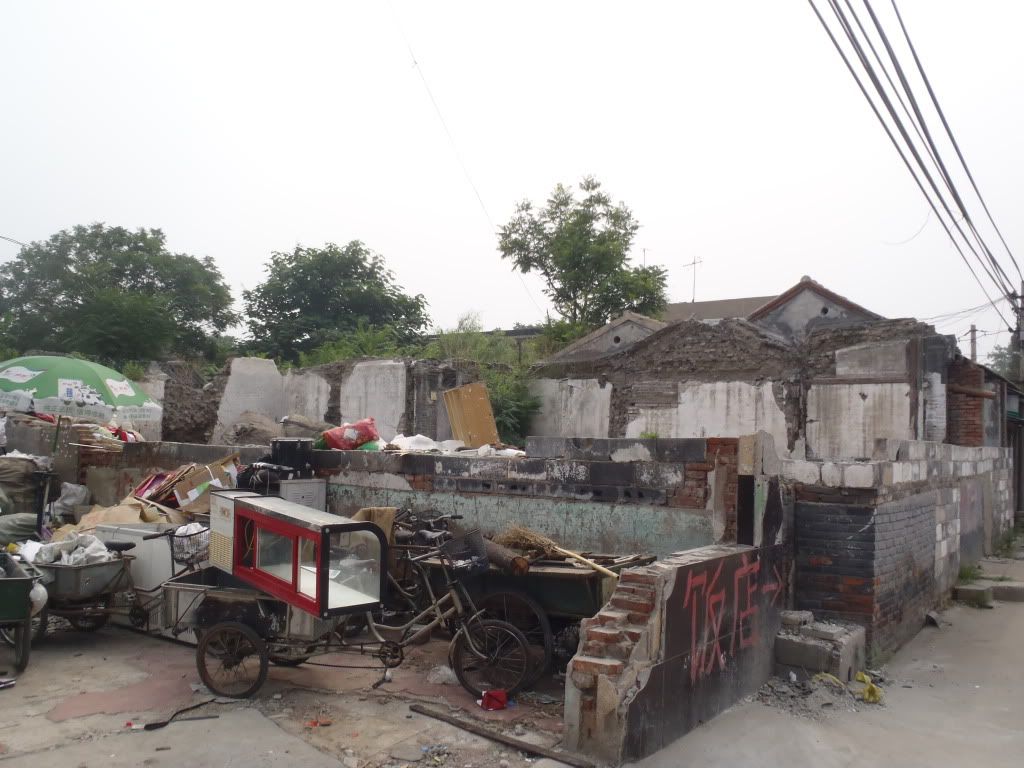
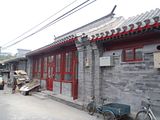
And then we see this sign:

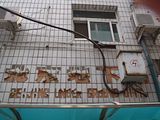
Right. Fantastic! Henk and I were somewhat comforted by the Chinese tourists as well as foreign tourists standing around the Underground City as well, unhappy about the result. We ended up walking back to a ‘The Pizza Company’ eatery we had spotted on the way TO the Underground City and ordered a nice big pizza and some cold ice-cream floats, sat and chilled out. Exhausted from the hellish day we just endured, we decided to give up on sight-seeing and head back. Henk was still feeling only moderately better and I’m sure the day’s events weren’t helping much.
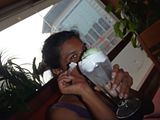
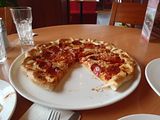
We got up early on the 23rd of July in order to pay our respects to Mao and his final resting place: smack-bang in the middle of Tian’anmen Square! As always there was a giant Chinese queue we had to make our way through. While Henk deposited our camera I stood in line and moved ahead – quickly! Before I knew it I was already half-way through the line (or more!) with no Henk in sight! Thankfully he eventually made it up to me and snuck in line next to me without any trouble. Once we got through security we were supposed to remain silent (which was quite difficult) as we approached the big man. Or should I say little man! Henk’s first comment to me when we left the mausoleum was that he was surprised how little Mao was. He also took-note that Mao’s face looked very strange – like it was extremely bloated and had half a pound of make-up layered on it. I wouldn’t be shocked if it did!
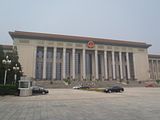
We bought some ice-creams to try and cool down and while Henk grabbed the camera from its storage place, I struck up a conversation with a Chinese guy who was buying ice-cream as well. Turns out that he was a tour-guide in training (he had taken the tour-guide exam 3 times!) and really wanted to practice his English. Henk and I gave him some tips and pointers about what he could say to potential clients. He actually ended-up inviting himself to go with us to our next stop, the Temple of Heaven. We took the metro and the three of us got tickets (well, he didn’t need any since he is a tour guide) and went inside. Now commenced our mini free tour of the Temple of Heaven! He helped us understand a little more about the Temple as we walked to different areas as we helped him with all his questions about English. And did he have questions! We must have answered hundreds for him until we were quite tired… he got the better end of joint commitment for sure! But that was alright with us because a guide in training is still better than no guide at all.
However the signposts still told us almost everything we needed to know. The introductory one read: “… built in 1420, [the Temple of Heaven] used to be a place where emperors of the Ming and Qing Dynasties went to worship Heaven and offer sacrifices to pray for… harvests and favorable rain. Most of the structures we see today were constructed in the Qing Dynasty in compliance with the layout system set in Jiajing’s reign of the Ming Dynasty.” One of the first areas we approached was the ‘Imperial Hall of Heaven.’ This was dubbed as the “heavenly warehouse of the altar of prayer for grains.” Our guide told us a little about the hall before leading us to a 3-tiered stone terrace with 8 stairways known as the ‘Hall of Prayer for Good Harvest.’ There was a stone bas-relief on the floor with dragons we took note of.
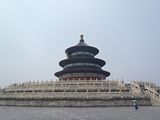
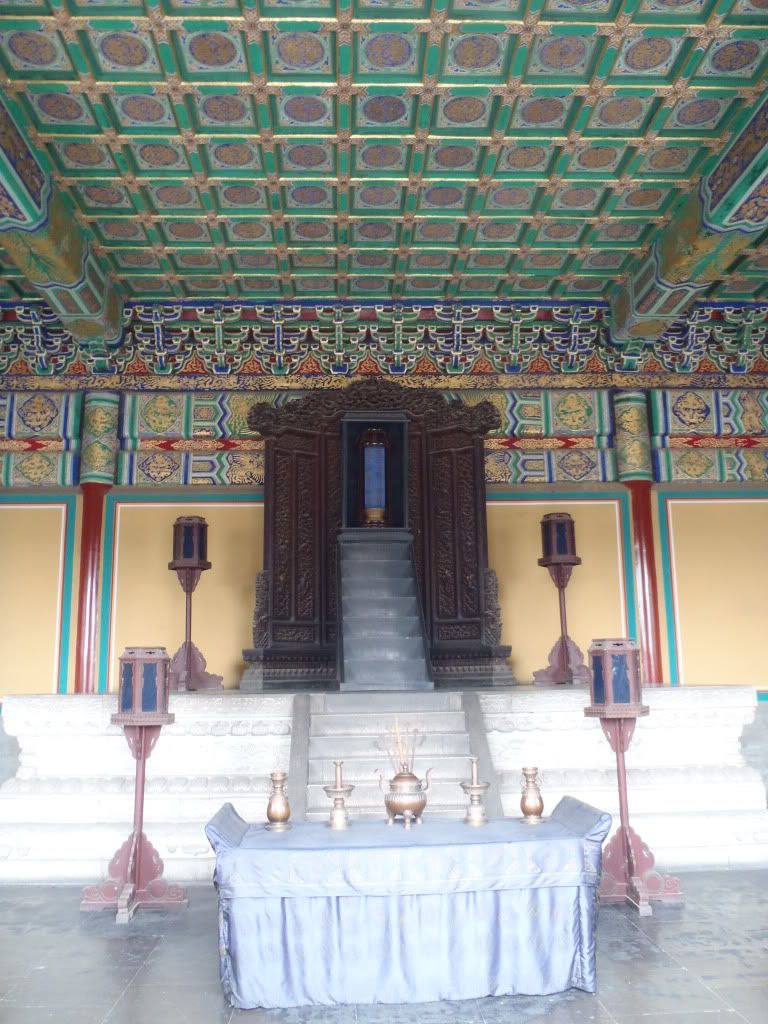
Next we headed to the annex halls which weren’t too interesting. The Fasting Palace also looked similar but had a bit more significance. The sign read: “[This] … was the place where the emperor used to exercise abstinence from meat, drink, music, women, and dealing with state affairs three days before conducting sacrificial rites at the temple. The Palace… is covered with green tiles symbolizing the emperor’s obedience to Heaven.” Almost finished with the complex, we spotted a tree on the way out labeled with ‘nine-dragon juniper.’ There were supposedly nine dragons to be found in the tree but we agreed that the Chinese must have very creative imaginations. (Aka didn’t look like anything!)
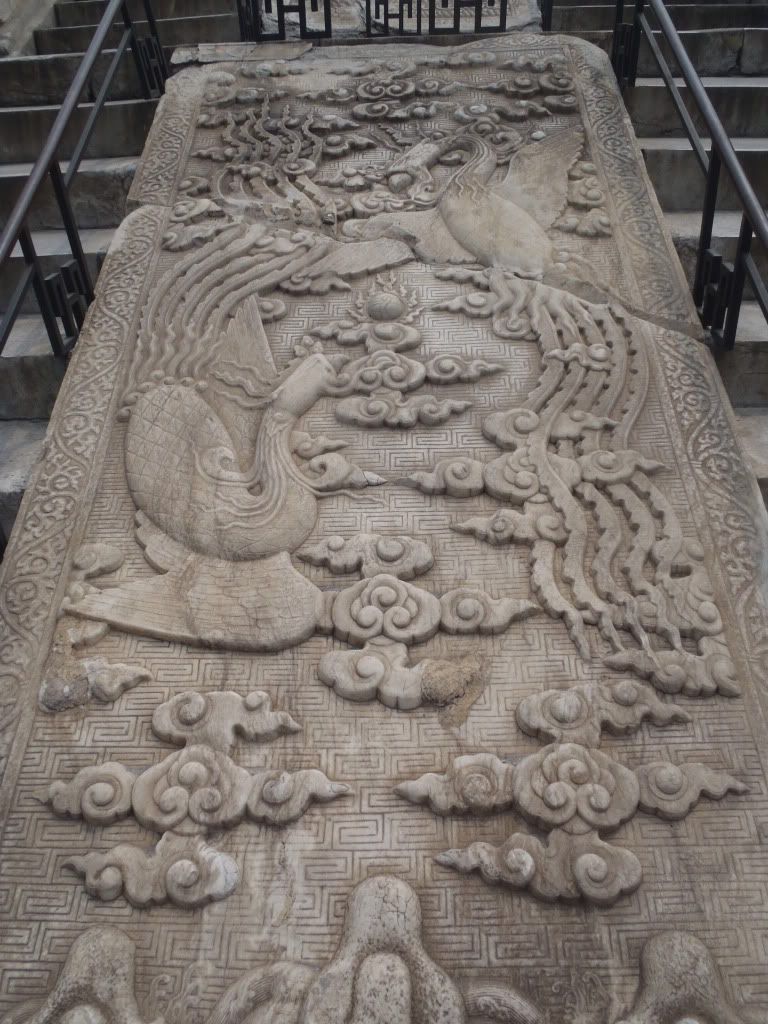
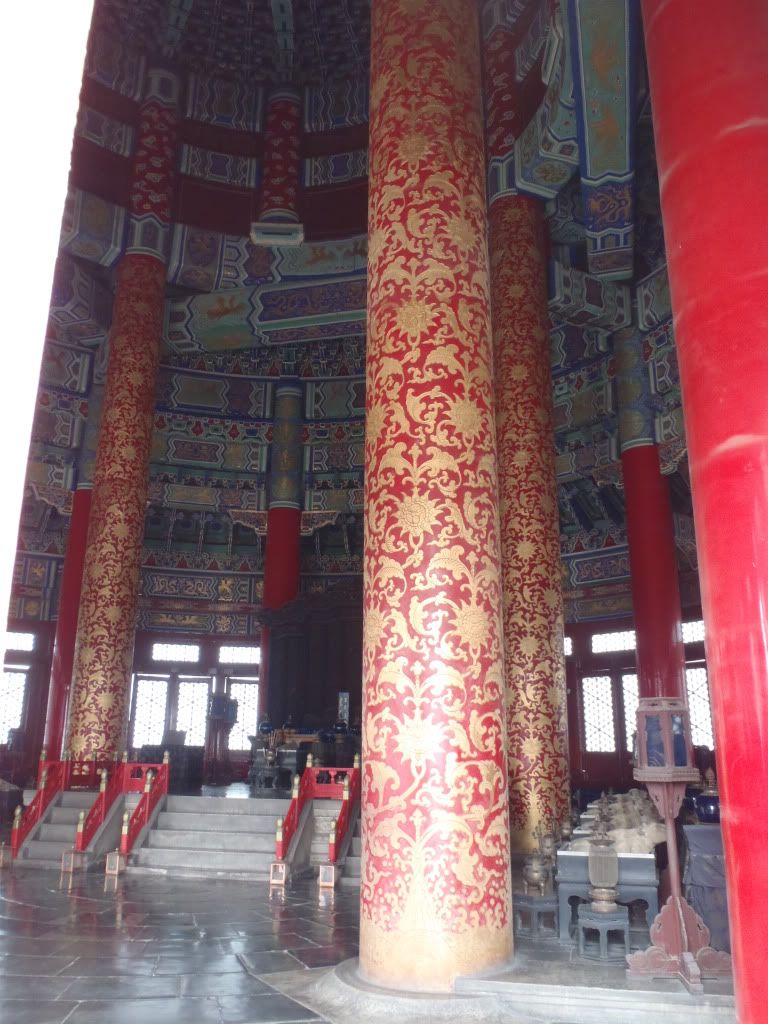
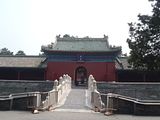
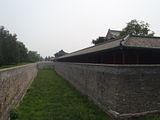
The last buildings we looked at were those around the circular ‘Echo Wall.’ If two people stand at the eastern and western annex hall points and speak those two people can apparently hear each others’ voices clearly. In the eastern hall there were dedications to the zodiac deities whereas in the western hall there were dedications to the natural deities of wind, rain and clouds. The Imperial Vault of Heaven was another circular building with a blue tile roof and a dragon playing with a pearl at the center and the ‘Circular Mound’ sat nearby as well.
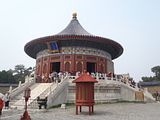
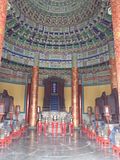
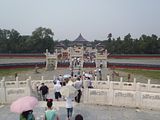
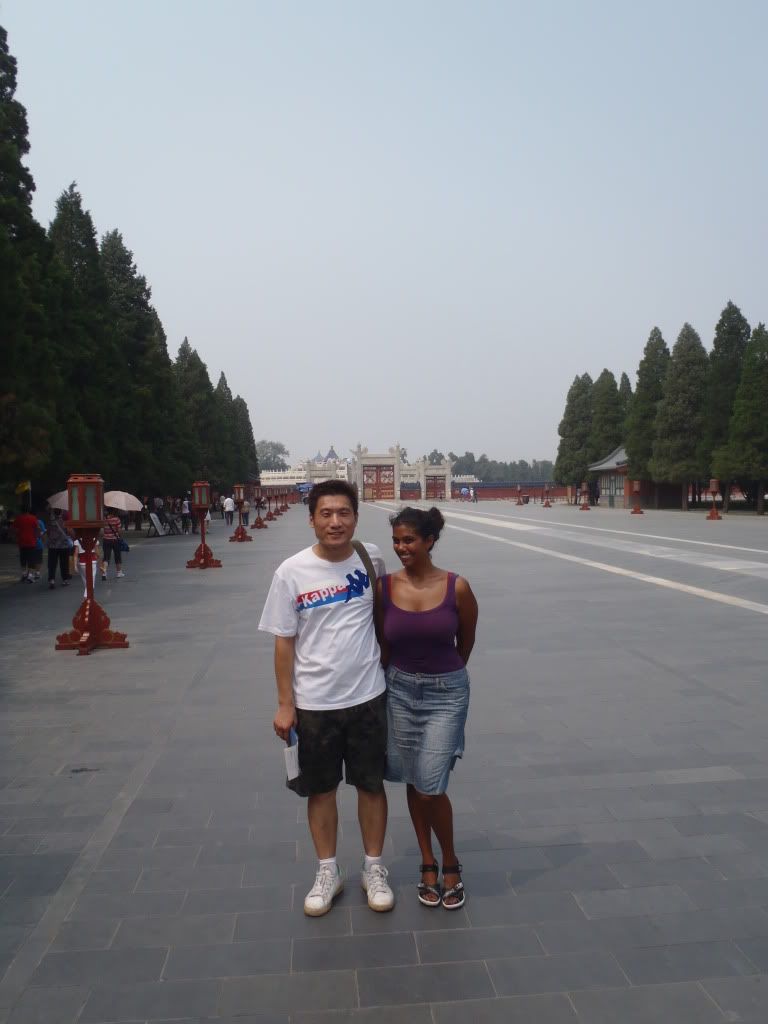
At that point we were starving for some lunch and decided to go to a Subway we spotted one of the days before. First we sat down upstairs in the nearby mall so I could eat something in a quieter, more relaxed setting than the noisy non-AC places downstairs. I recognized the mall we were in from my first visit to China… it was the famous area where they sold tons of fake luxury goods. Anyways, I got some average spaghetti and decent garlic bread before deciding it would be nice to get a manicure/pedicure after such a long break in having any. Henk got himself a sandwich to eat while I was doing this from the Subway but sadly they put too much mustard on it so it wasn’t very good! We attempted to get my eyebrows done after this, but everywhere wanted to charge higher-than-New York prices and we weren’t convinced. Furthermore the lady we finally agreed to had obviously never done it before as she was opening a brand-new box with waxing supplies. We ran out of there as fast as we could!
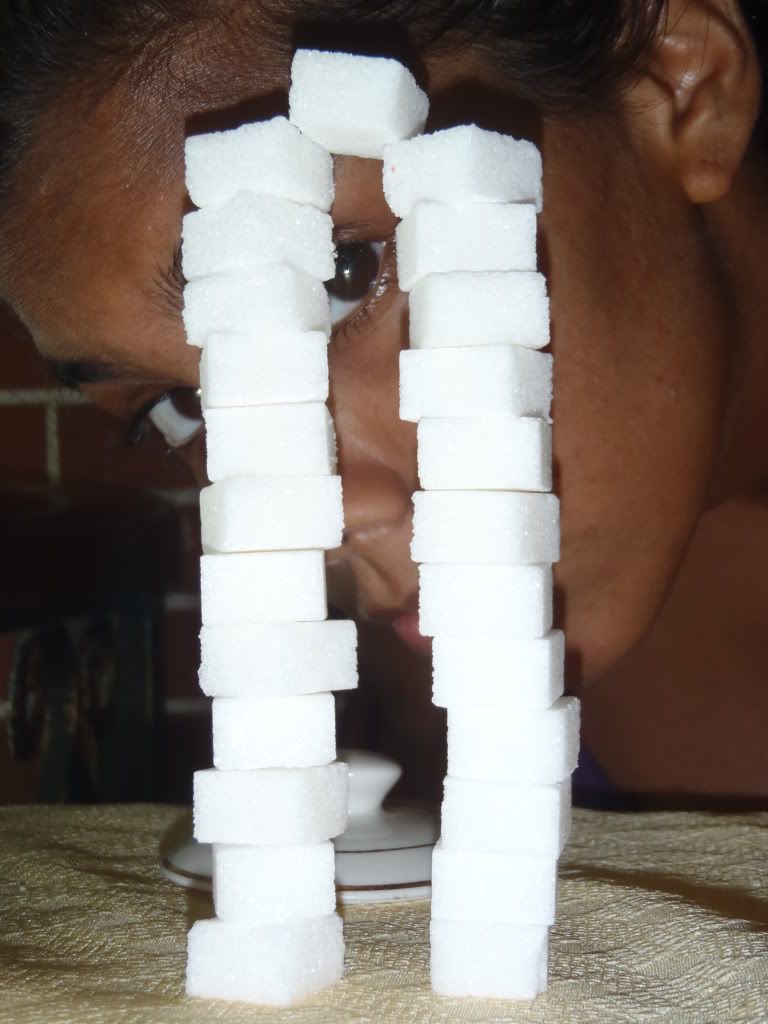
That evening we went to the Red Theater for a really interesting show I found online. Armed with some concession-stand bought sodas and popcorn, we settled into the front row to watch the story unfold. It was a kung-fu show and I’d never seen one before so I was curious what it would entail. The quote I read on their website said we would be taken on a journey with a little boy from his initiation to his journey to Zen master, and further said this:
“In an ancient temple perched high on the side of a mountain, we encounter a little boy, through practicing Zen Buddhism and Kong Fu, our little monk eventually grows and finally reaches the sacred goal of enlightenment… The best Kung Fu practitioners from all over China have been found for this production and it shows on the stage. Their average age is just 17 years old! Additionally the costumes, set design and special effects are up to international standards, created by some of the best stage directors and designers in China.”
The show used the storyline of a boy becoming a kung-fu master as an outline for showing the audience a bunch of super-impressive kung-fu skills. There were little kids, looked about 7 or 8-years-old doing headstands combined with kung-fu jumps and other moves. The older kids each had personal ‘solos’ where they broke wooden boards on their heads or battled with each other. We were also shown various weapons used in conjunction with kung-fu moves – very entertaining. The parallel between animals and their respective kung-fu moves they were named after/resembled was very clear here. We took a taxi to the train station once the show was finished and went back to Kevin’s. Tomorrow would be an early start once again for our journey to the Great Wall of China!
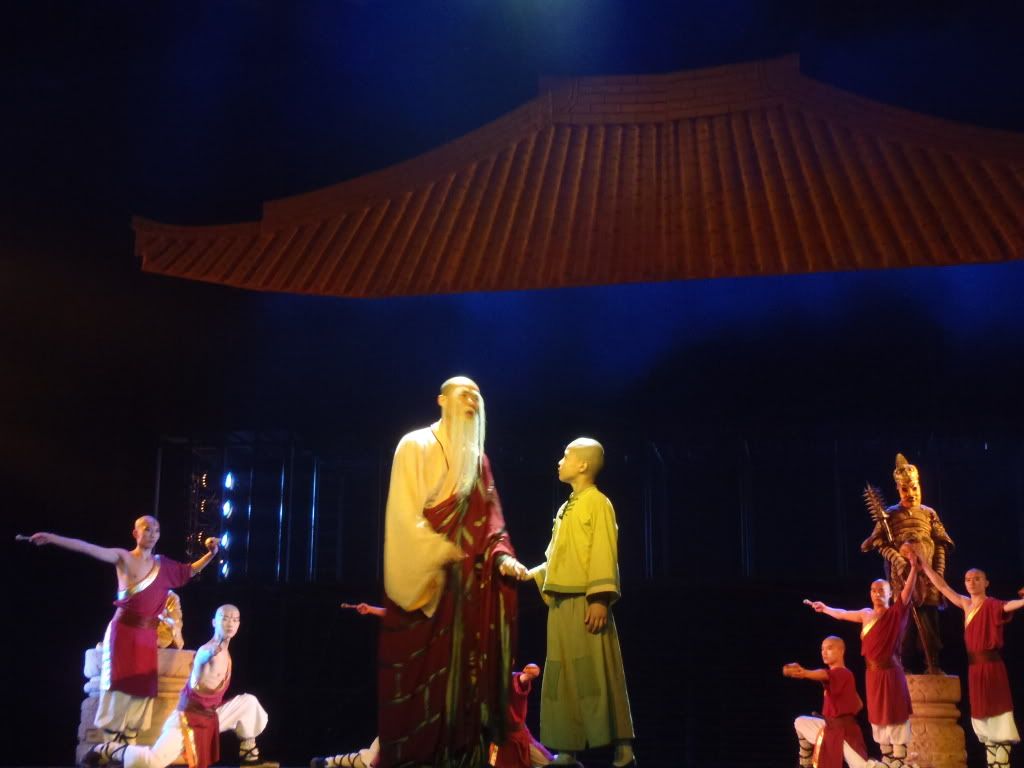
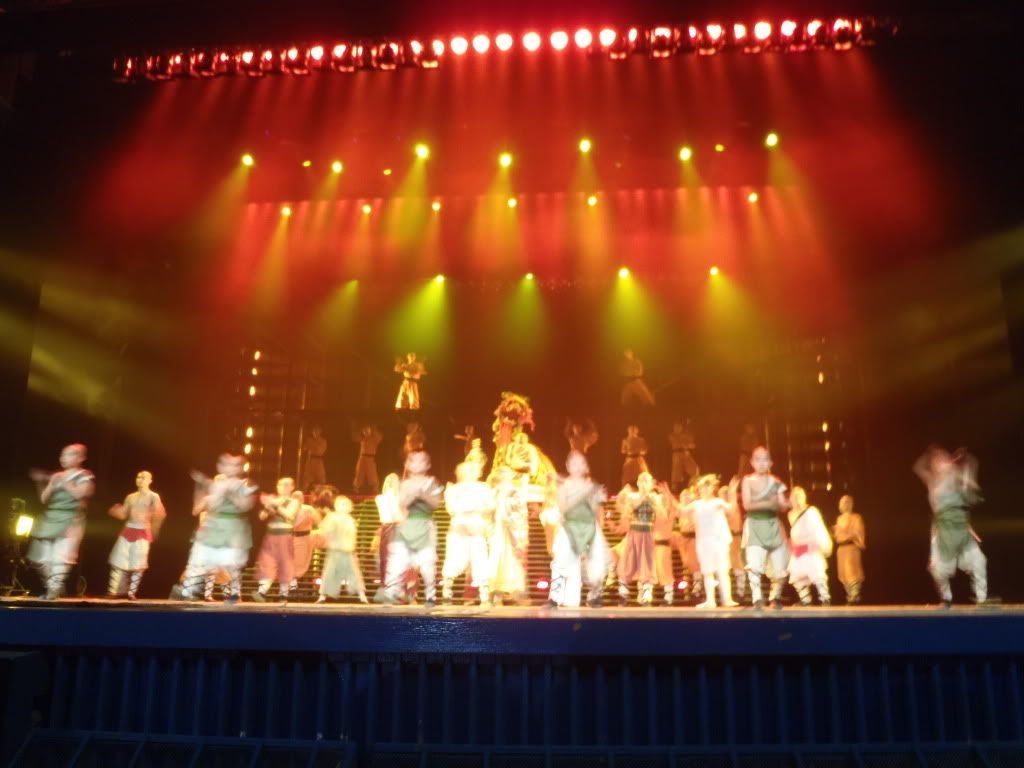

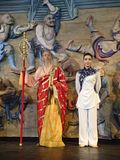
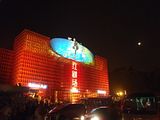
Francesca
Wednesday, July 21, 2010
The Forbidden City
The journey to Beijing was uneventful, with Francesca spending most of the time sleeping on my lap. When we arrived in Beijing I called our upcoming host, Kevin Xie. Kevin had offered to host us for a few days and we were excited to stay with him. He told us that we should come to his office first, since he was still at work. We took the train and met Kevin outside of the station. He asked us if we were hungry and took us for a bite at a nearby restaurant. It was too kind of him to buy me a salmon risotto and Francesca a cheese pizza. Kevin told us about his company, which he had begun to create a Chinese version of MeetUp (a site where you can register as a group and set up meetings). Their project was about to go live and they were still working frantically to get some last minute bugs out of the way. The food was followed by the walk to the office, where we met his staff and sat around for a while planning our evening.
Francesca had been very excited to show me the Beijing Opera, one of the many things she’d seen on her previous trip to China. We’d managed to get some cheap tickets online and had to pick up the tickets before the show. Due to time-constraints we couldn’t go back to Kevin’s place with him after he was done working. Luckily he offered to take our bags with him in the taxi after we’d taken the train to the station nearest to his house: Tiantongyuan North. He also told us to call him when we had returned to that station so he could arrange for a driver to pick us up and bring us to his place.
Francesca and I turned around after that and sat for another 50 minutes to meet the sales person. We had a little trouble locating her, but in the end we found the lady (called Iko) and were taken to the Qianmen Jianguo Hotel and its Liyuan Theater. We had a nice chat along the way and also asked for tips on getting to the Great Wall. Iko took us to our seats, right in front of the stage! There were even snacks waiting for us. Francesca talked to the elderly couple from Tasmania for a while, whilst I procured a headset for her that would give a little extra information on the Opera. I even got to take some pictures of the actors putting on make-up on.
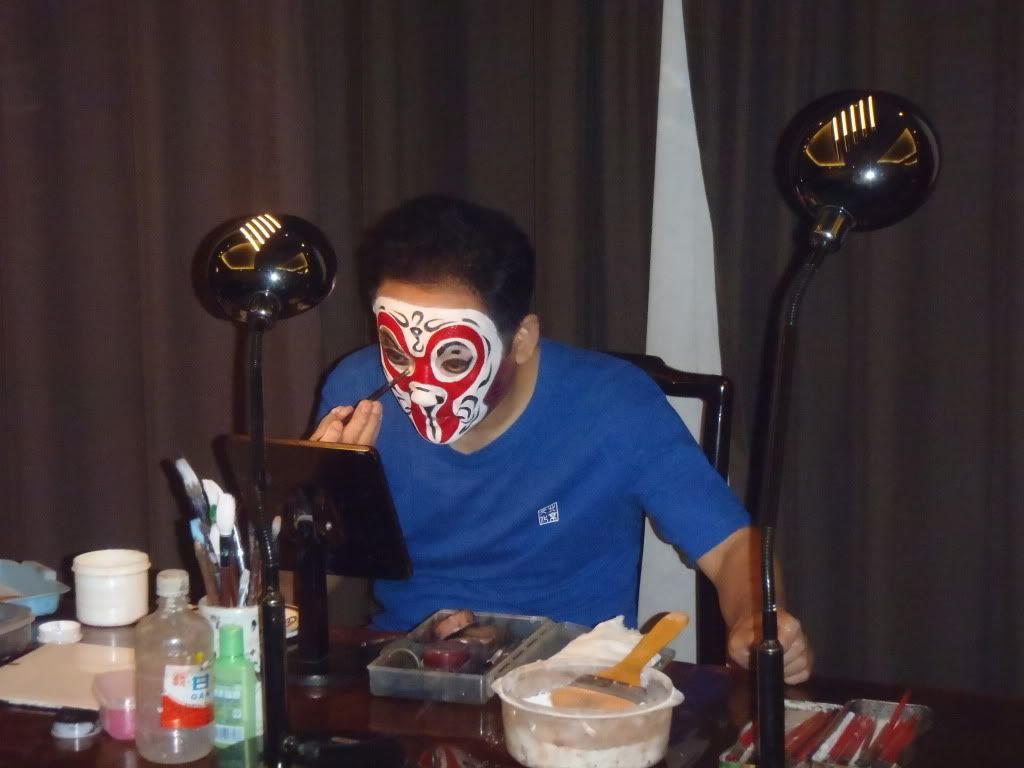
Francesca told me later the colors of the make-up signify different personality traits. “Different colors such as red, yellow, blue, white, black, purple, green, gold and silver are used for facial make-ups. The main color in a facial makeup symbolizes the disposition of the character. Red indicates devotion, courage and uprightness. Yellow signifies fierceness, ambition and cool-headedness. Blue represents staunchness, fierceness and astuteness. White suggests sinisterness, treacherousness, suspiciousness and craftiness. Black symbolizes roughness and fierceness. Purple stands for uprightness, sophistication and cool-headedness. Gold and silver colors are usually used for gods and spirits.”
Right before the show started our table got some pre-entertainment. A guy came over to pour tea for us and didn’t do this the boring old British way… No, he juggled with the pot for a while before pouring the tea from a meter over the cup.
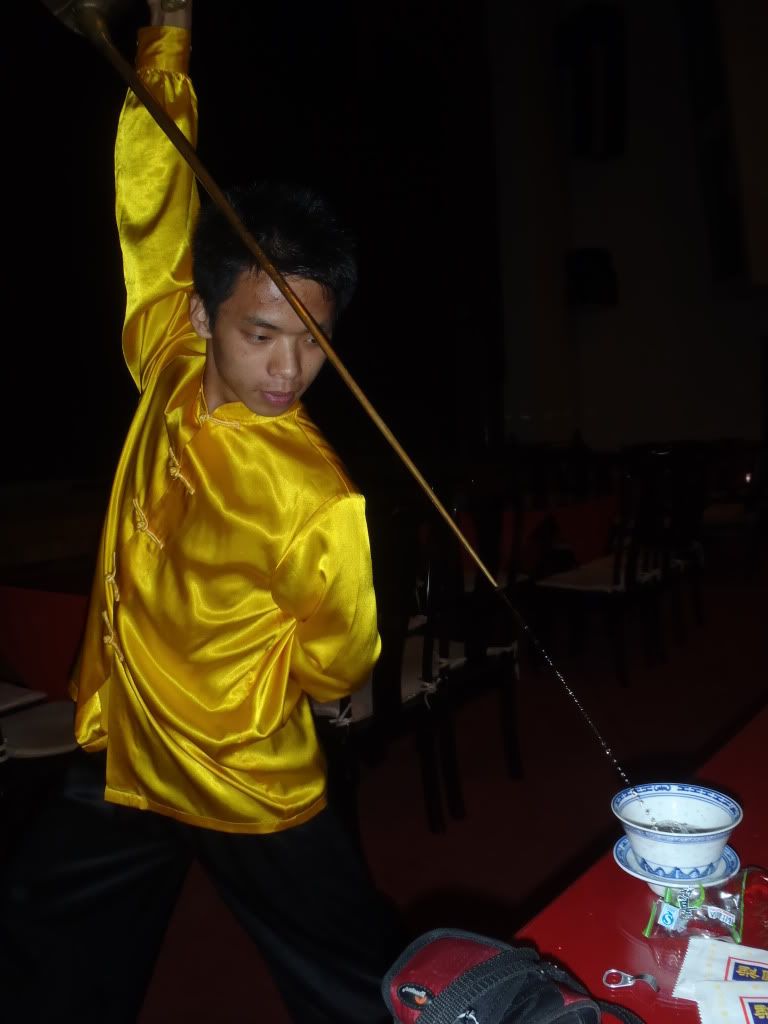
Around 7:30 PM the show got under way. The orchestra sat on the stage and played us some songs. Soon they were replaced by a singing lady, who told us the story of ‘Autumn River .’ It tells of the nun Chen, who meets the young scholar Pan, a nephew of the head nun, whilst he is studying at the nunnery for his exams. Chen and Pan fall in love, but the old nun disapproves and sends Pan away. When Chen finds out her lover is gone she makes her way to the river and looks to an old boatman for help. What follows is an entertaining dialogue between Chen and the boatman, who promises speed, but delivers nothing. Translations of the conversation popped up next to the stage – another cause for laughter since the Chinglish was quite amusing.
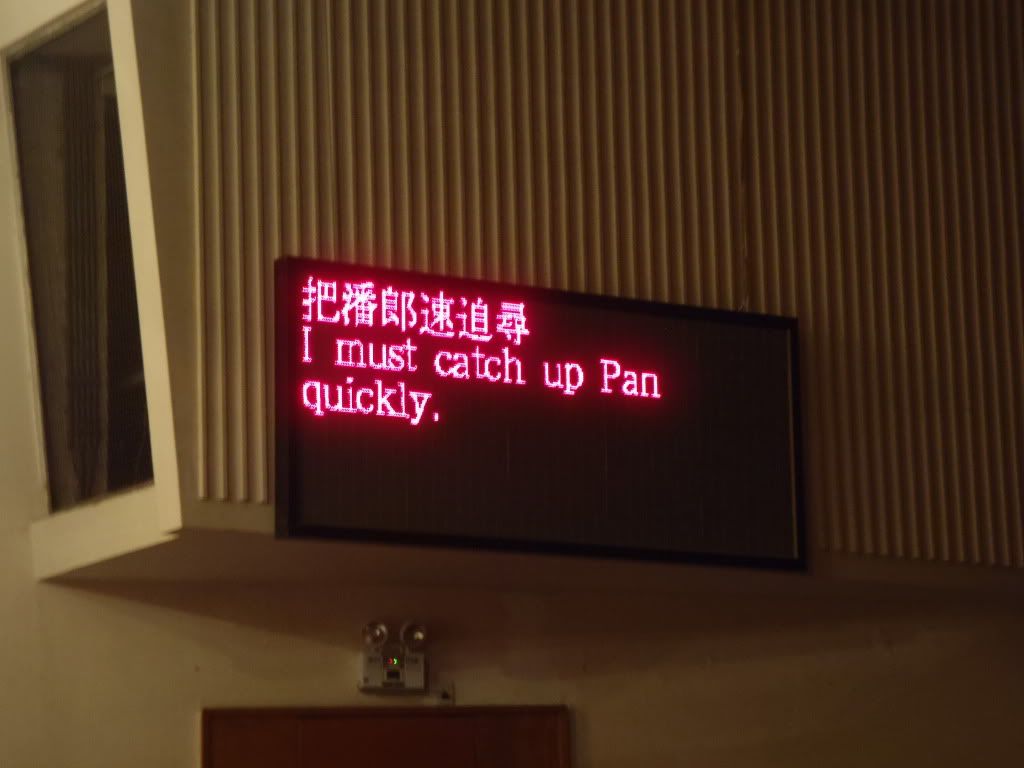
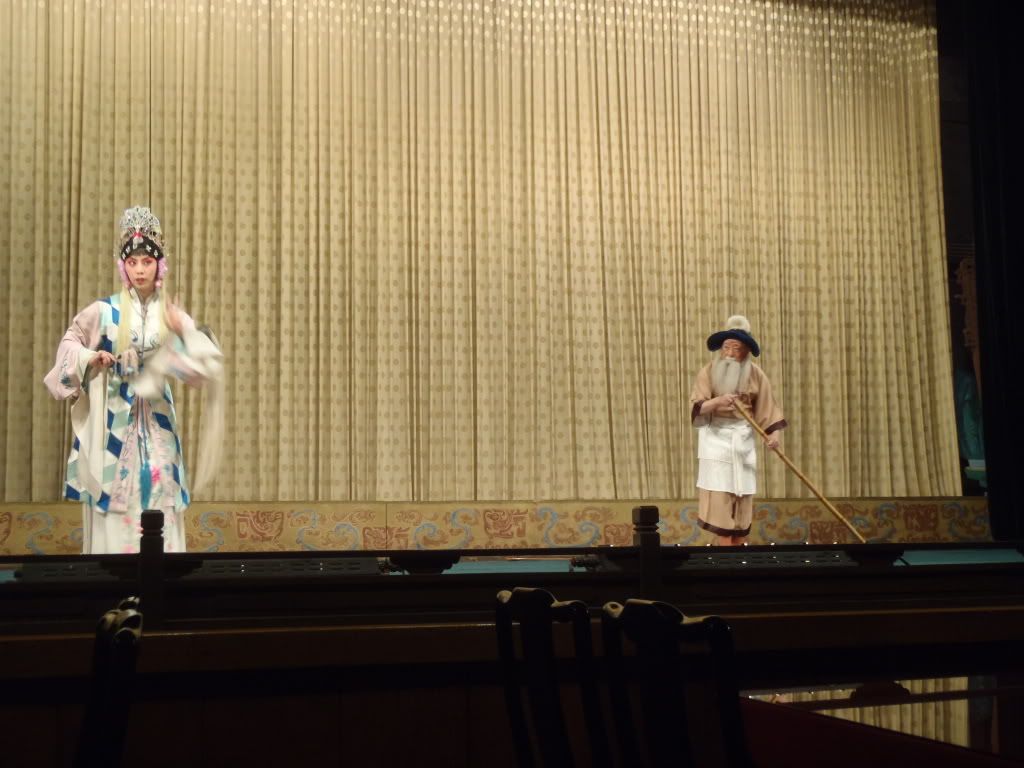
Much more impressive was the acrobatics shows called ‘The Monkey King Fights Against 18 Warriors.’ There was not a whole lot of dialogue, but the show made more than up for it. We saw the Monkey King go up against different enemies once, each bringing different tricks to the table but in the end all getting defeated. We later found out that the Monkey King was betrayed by the Gods on multiple occasions and had taken revenge by eating the Peaches of Immortality. As the Journal of Theatrical Combatives describes it: “Horrified, the gods mount their forces, including the Horse King, the River God, and other Immortals, and prepare to engage the Monkey King in battle with the intent to destroy him once and for all.” The fighting scenes were quite intense and definitely a pleasure to watch. I got some good pictures, but this video will show you a highlight of the evening!
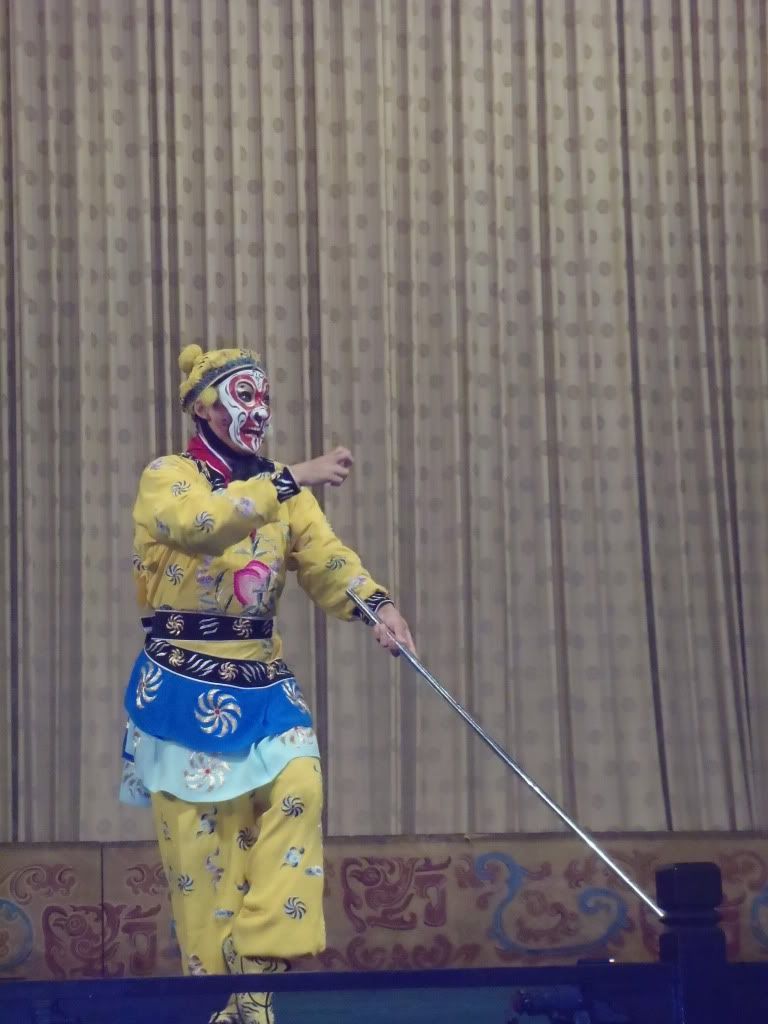
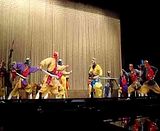
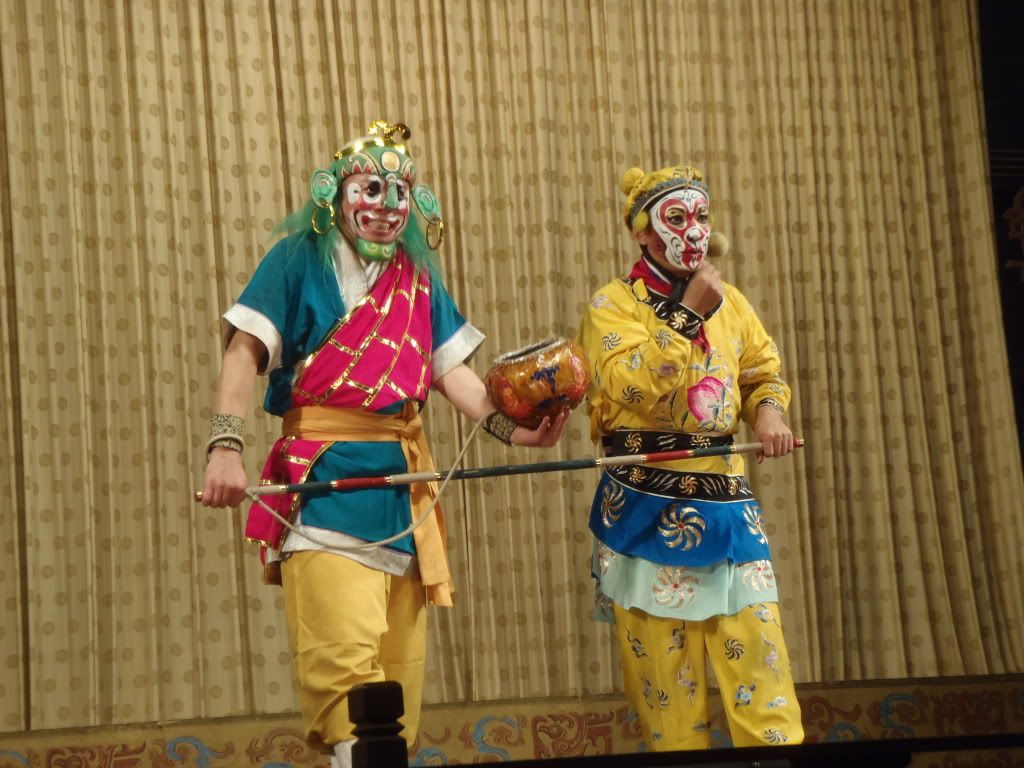
The show ended about an hour after it started. We spent some time looking at some extra information about the Beijing Opera, after which we went outside to grab a taxi and look for a nice restaurant. Francesca had been craving her Peking Duck and the Lonely Planet had listed several recommended places. I looked for the closest one and showed it to the driver. He wasn’t entirely sure how to get there but dropped us of on an intersection nearby. Sadly, Lonely Planet’s map was inaccurate and we spent the next hour walking around trying to find the restaurant. We were sent in different directions by locals and in the end just gave up when the clock struck 10:00 PM. We figured most restaurants had to be closing be now and we didn’t want to miss the last train either.
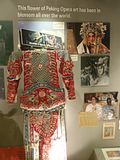
Around 11:00 PM we finally reached Tiantongyuan North again and found the driver to take us to Kevin’s place. I sat down with him for a while and he even warmed up some food for us, since we were still hungry. It was nice to talk to him, but we were both tired and sleepy, so Kevin and I prepared the beds in the separate room (with A/C! mandatory in Beijing’s relentless heat). Sleep came easy that night.
The next morning Francesca and I got up around 8:00 AM for an early start. We wanted to go to the Forbidden City and we figured we’d need most of the day for it. We took a taxi with Kevin to the subway station and then jumped on the train to Dongdan to switch trains to Tian’anmen Square. We popped up on the wrong side of the road, and weren’t entirely sure where we were. We just started walking and ended up looking at a large picture of Mao. We followed the people inside and soon realized we’d entered the Forbidden City.
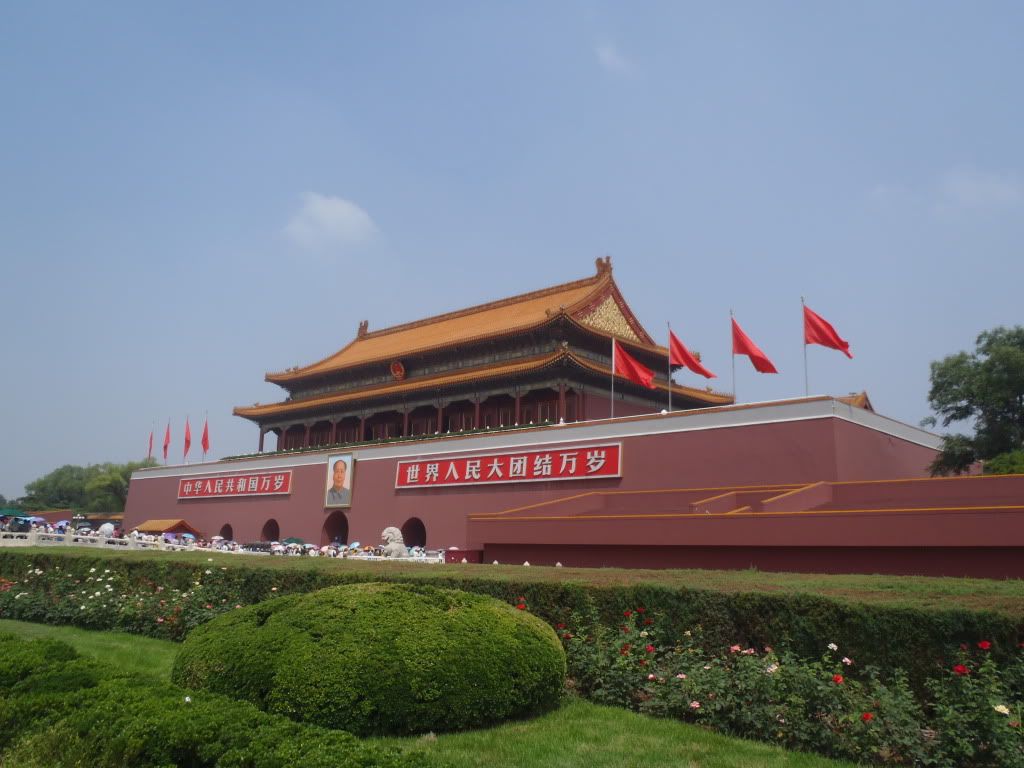
The queues for the tickets were seemingly endless. Furthermore, the sun was making it a pretty hot day. I wanted to spare Francesca the waiting and told her to sit down whilst I went for the tickets. I checked out the queues and realized one was much shorter than the others: the guides queue. I figured I’d just play dumb, hoping to get away with it. Whilst queuing I ended up talking to an American and his guide, who said I couldn’t get the tickets this way. I stayed put and even asked her to buy them for me. After a while she accepted, mostly because I said we’d be interested in her guiding services. Long story short: she got us the tickets and we joined her tour.
Francesca had already been to the Forbidden City, but for me it was a new experience. The mind conjures up a grand palace with magnificent halls. The truth is that it was all a little less spectacular than I had expected. But, first things first: I can’t leave you without any information about the Forbidden City after all.
The site of the Forbidden City was chosen after the second Ming Emperor Zhu Di moved the capital back from Nanjing to Beijing. The City’s construction started in 1406 and lasted until 1420. Over 1 million workers put their sweat, blood and tears into the project. The name is a translation of the Chinese ‘Zijin Cheng, ‘ which literally means ‘The Purple Forbidden City.’ ‘Purple’ because it refers to the North Star, which in turn signifies the Celestial Emperor; ‘Forbidden’ because only the Emperor could grant access to the palace; ‘Cheng’ because its literal translation is ‘walled city.’
Until the start of the 20th century the Forbidden City remained the center of Imperial power. A total of 24 Emperors from 3 different dynasties made it their home. Finally, in 1912 the last Emperor of China, Puvi of the Qing dynasty, was abdicated. The new Republic of China let Puvi live in the Inner Courts for some time, after which the artifacts were taken to safety. Finally, in 1987 the Forbidden City was declared a UNESCO World Heritage site.
That leaves us with the city itself. Our guide had us enter through the Meridian Gate, the largest of the 4 gates to the City. We crossed a few bridges and ended up in front of the Hall of Supreme Harmony. It was the ceremonial center of imperial power, and is also the largest surviving wooden structure in China. We admired the imperial throne inside for a while, listening to our guide’s explanations. We then continued north to the Hall of Central Harmony, a smaller, square hall, used by the Emperor to prepare and rest before and during ceremonies. Behind it, the Hall of Preserving Harmony, was used for rehearsing ceremonies, and was also the site of the final stage of the Imperial examination.
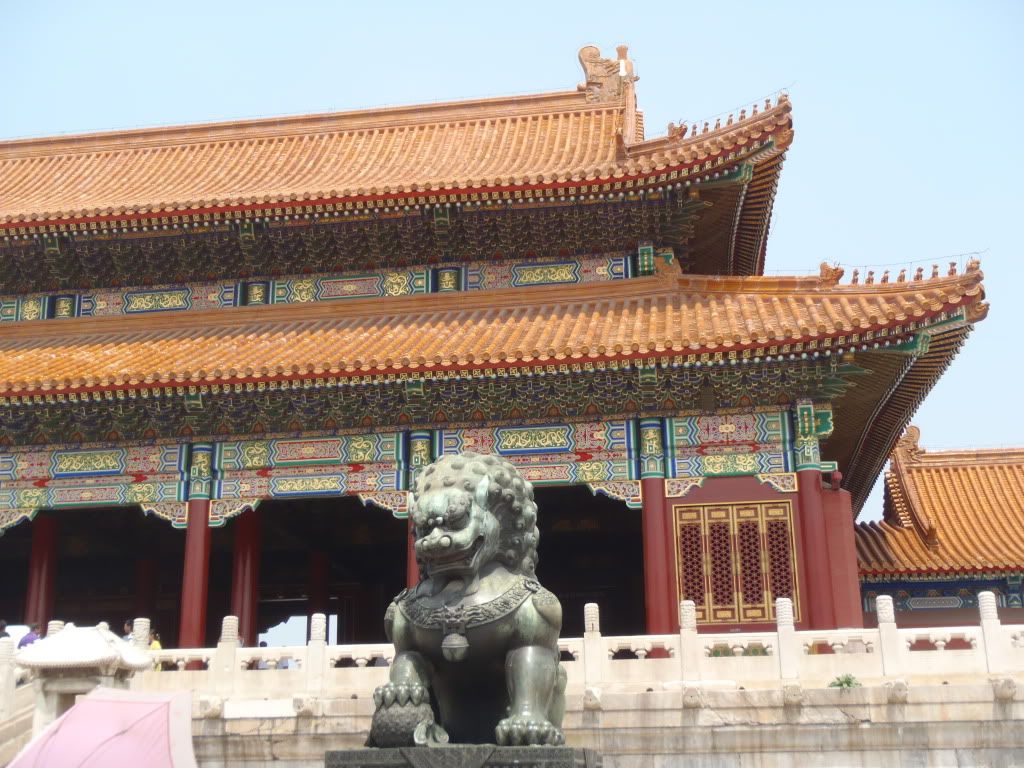
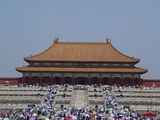
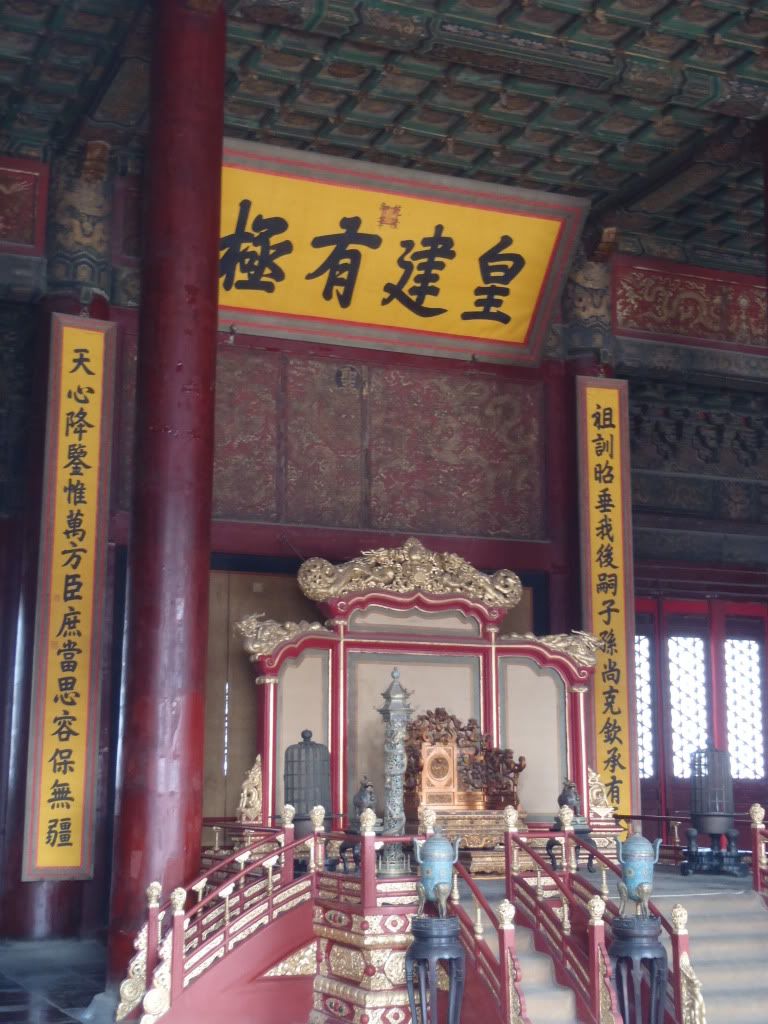
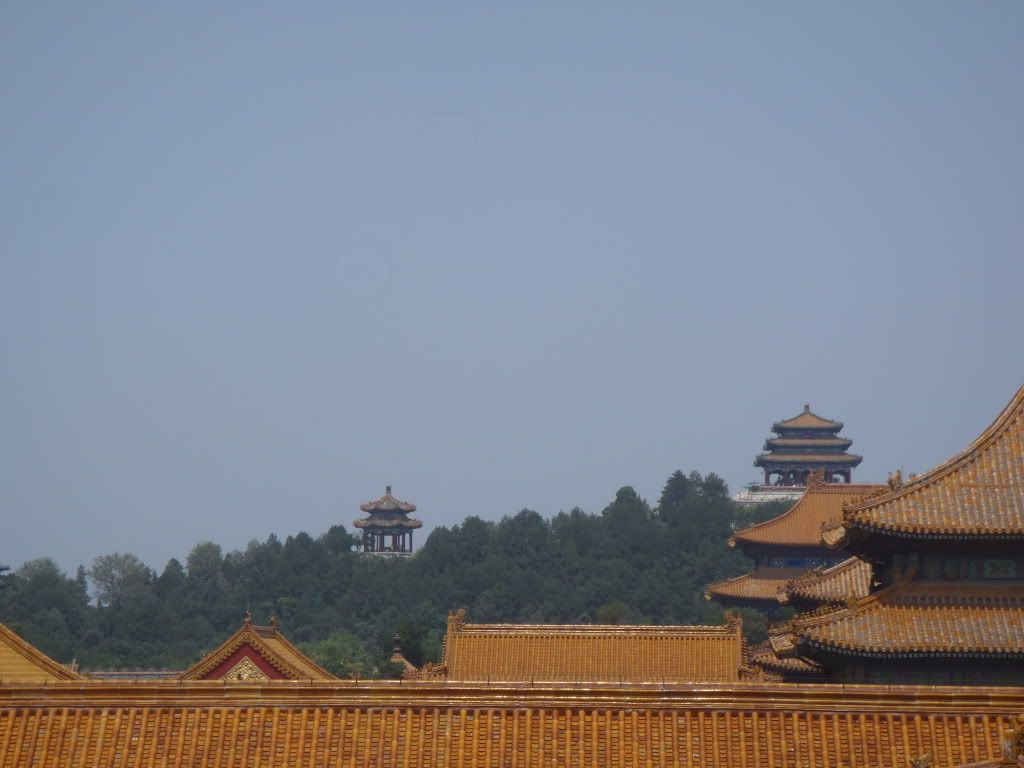
We took a little detour after these 3 halls and had a look at the artifacts in the Palace Museum. The exhibition was called ‘The Qing Emperors Grand Weddings’ and showed us all sorts of items used during these ceremonies. Highlight for Francesca was our guide’s explanation of the Ruyi, an item she had bought back in 2007 but never understood what it was used for. It turns out that it’s not a backscratcher or a belt hook… No, it’s a gift given by the Emperor to his concubines-to-be. The material decides the importance of the Ruyi, for only the jade one meant marriage for that lucky girl.
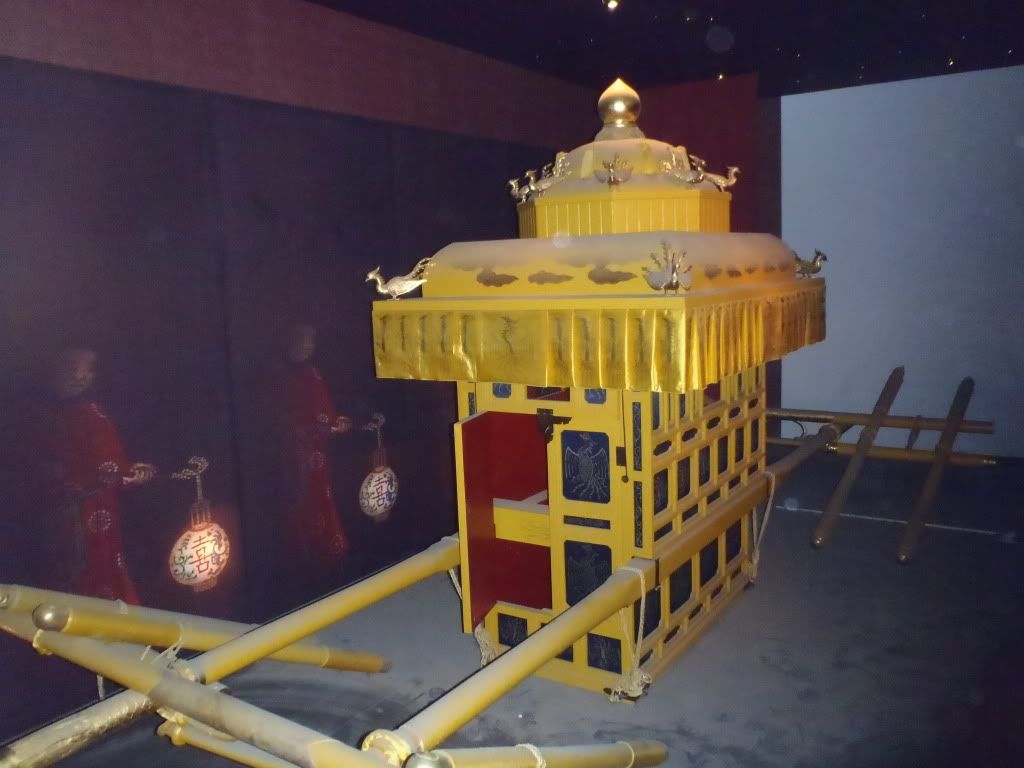
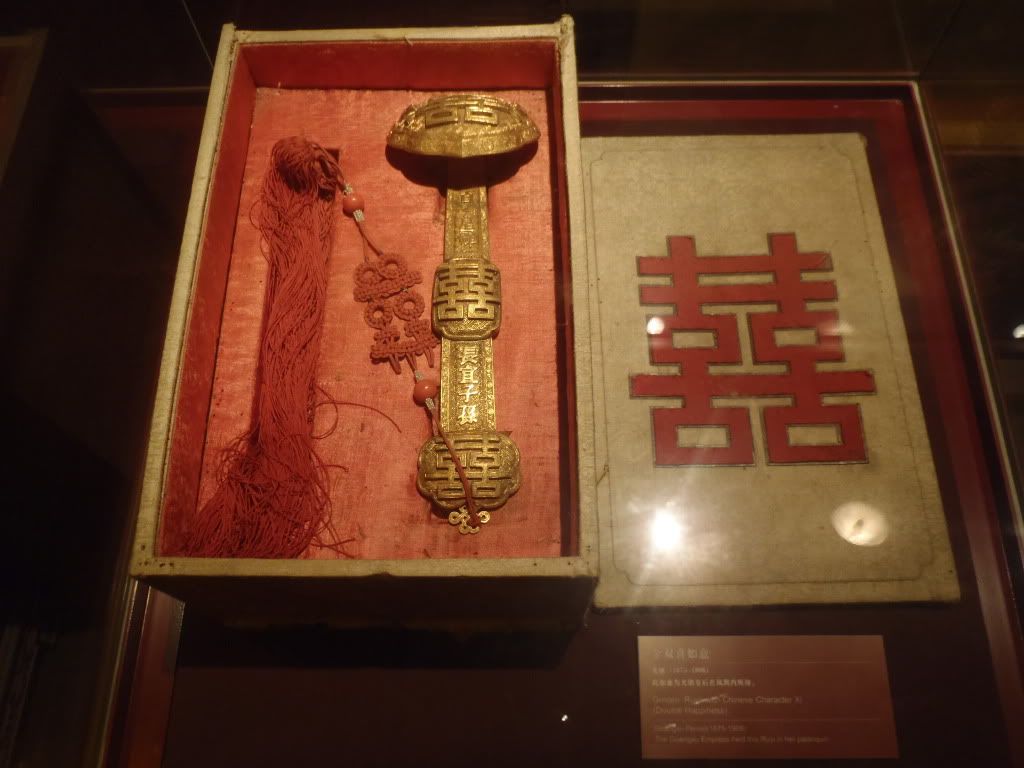

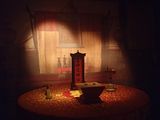
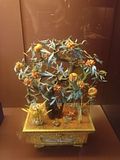
The tour continued with 3 halls in the Inner Courts of the City: The Palace of Heavenly Purity, The Hall of Union and Peace, and The Palace of Earthly Tranquility. I know, such serious-sounding names! But, there is a reason for all this eloquence, for these halls were used as housing for the Emperor and Empress. Wiki summarizes it perfectly: “The Emperor, representing Yang and the Heavens, would occupy the Palace of Heavenly Purity. The Empress, representing Yin and the Earth, would occupy the Palace of Earthly Tranquility. In between them was the Hall of Union, where the Yin and Yang mixed to produce harmony.”
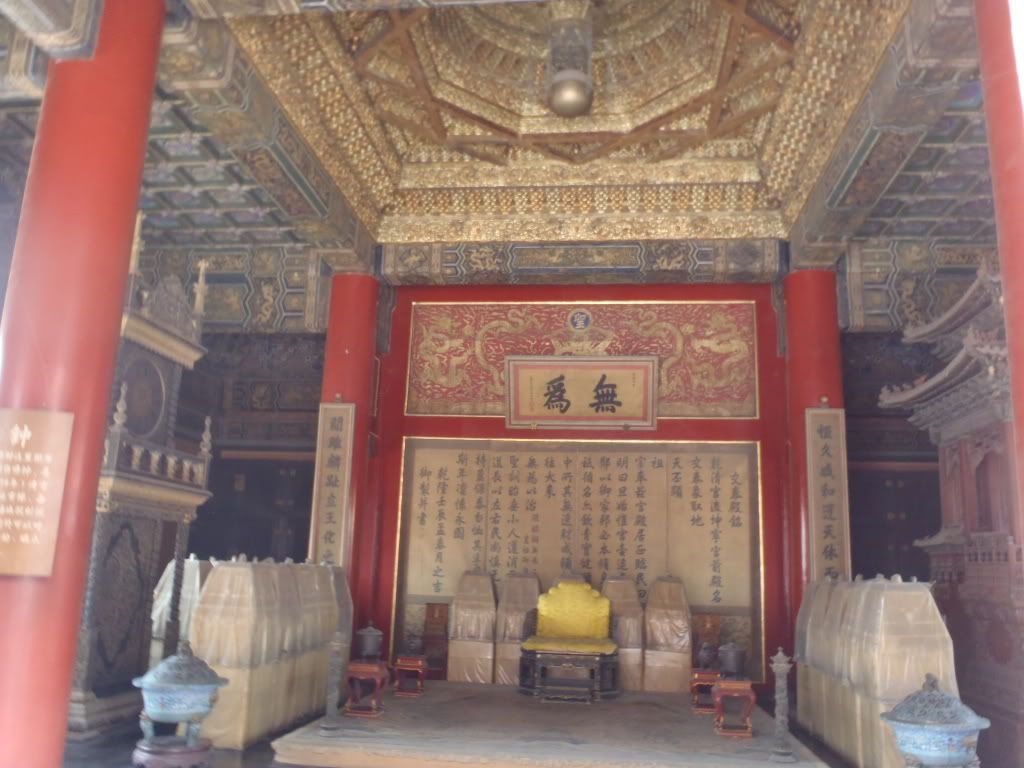
Again it was time for a detour, as our guide took us for a mandatory stop in one of the many calligraphy and arts shops. We were tempted to buy something, but decided it wasn’t worth the risk or money and spent a few Yuan on ice creams instead. Since our American companion did decide to buy something we had to wait for a while. Our patience was not tested for too long as the guide walked us through the Imperial Gardens. According to the signs the Gardens were used for amusement by the Emperors, Empresses and imperial Concubines. Furthermore, the Emperor used this place to expand his ever-growing harem. The Hill of Accumulated Elegance was the highlight of the Gardens, reaching 10 meters high and carrying some neat carvings of dragons and lions.
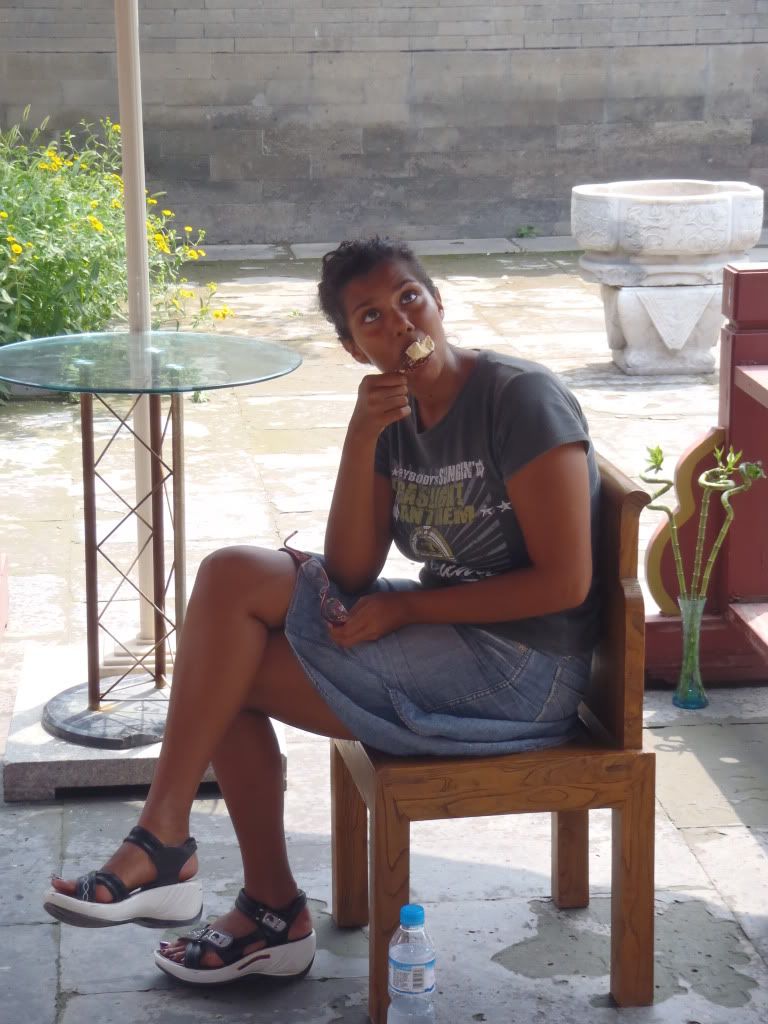
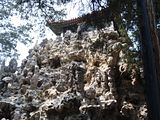
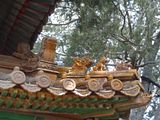
Our tour ended at the Gate of Divine Might, where we said goodbye to the American, paid the guide and walked off. We spotted the Jingshan Temple up on the hill in the distance, but decided we needed to get moving to admire some other attractions nearby. However, having just traversed the Forbidden City’s impressive 1 kilometer by foot we had set our sights on a taxi back to Tian’anmen Square. Finding one wasn’t a problem; finding one that would take us was… Empty cab after empty cab passed by, leaving us suffering in the heat. Our benign theory is that the drivers weren’t allowed to stop where we were standing. Knowing the Han Chinese a little by now though, we think it might also be laziness (not wanting to speak English) or plain old racism (something the Han Chinese are infamous for.) Either way, I ended up finding us a bus to the Square.
The bus let us off near Mao’s Memorial Hall, which we found closed. I made a mental note of the opening hours and led Francesca past the Qian Gate, Beijing’s largest and supposedly most beautiful gate. We couldn’t get ourselves to climb the steps and continued walking. I tried to follow Lonely Planet’s map to get us to the Police Museum, but ended up on several wrong streets. We did spot the Beijing Railway Museum, but decided that would be a waste of time. We figured the outside looked nicer than the inside ever could. Luckily some cops finally pointed us in the right direction. We weren’t allowed to take pictures inside, but frankly, it wasn’t worth it. Most of the artifacts on display were relatively new guns and rifles. A little more interesting were the pictures of criminals. Unfortunately the English captions were very usually no more than a few words, so the stories behind the photos were lost on us.
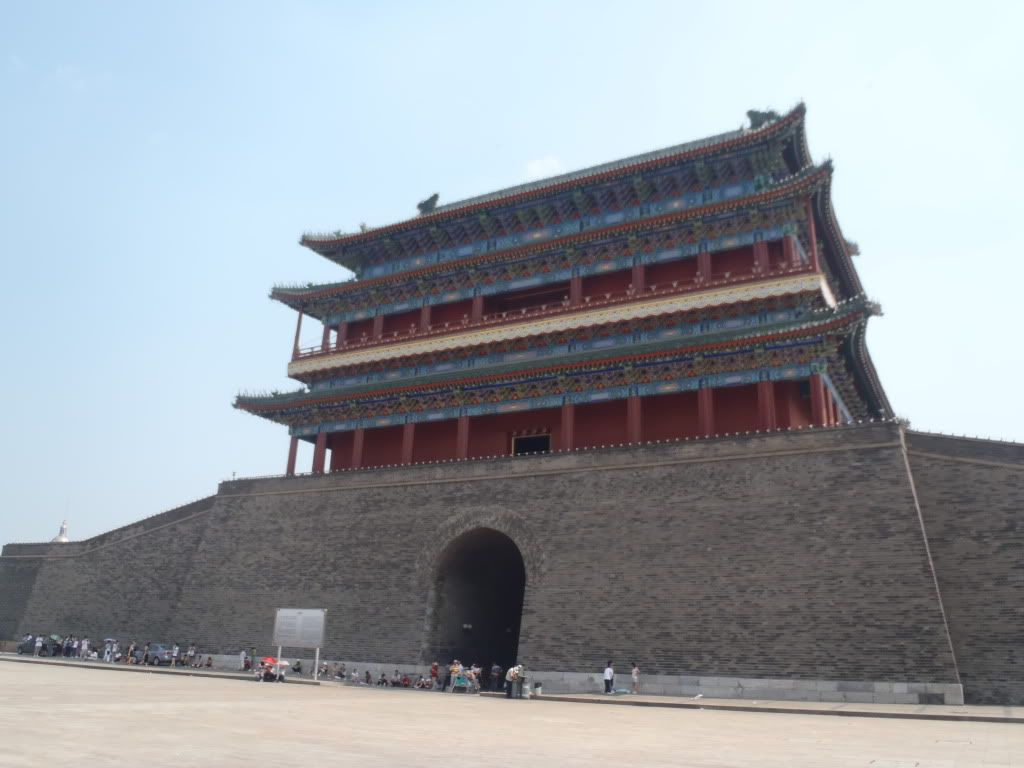
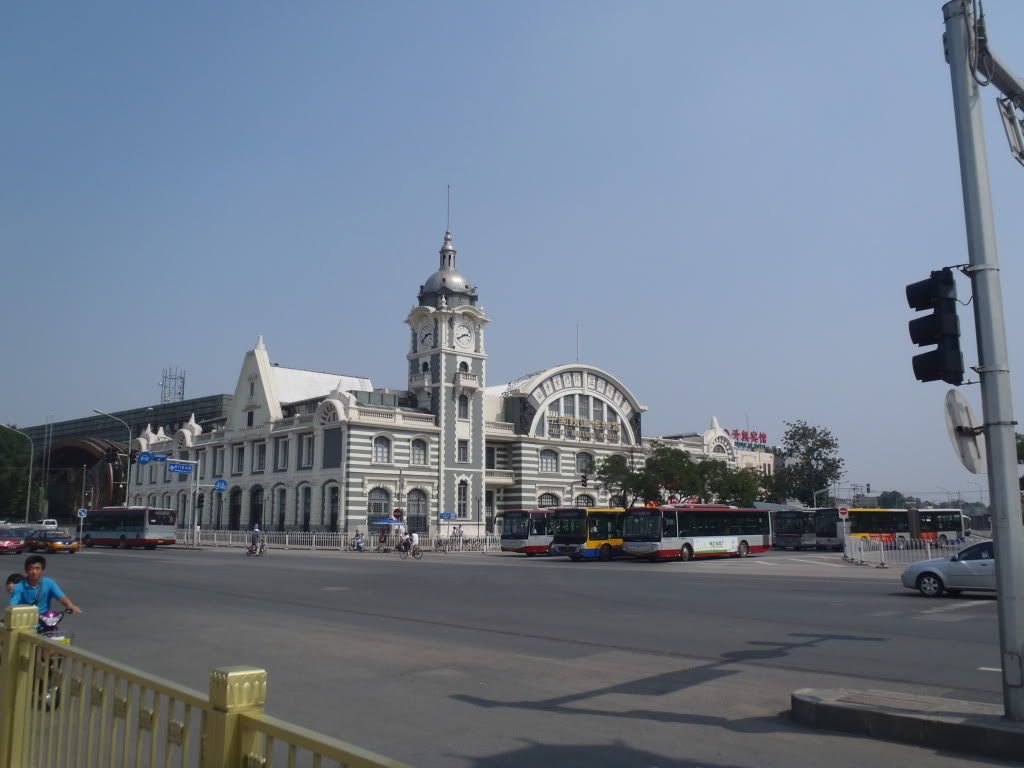
Walking back to Tian’anmen Square to find a taxi was another challenge. Again, drivers kept on passing us… When we finally made it back to the main road Francesca spotted a parked cab with a smoking driver. He smiled when I showed him directions to the restaurant we wanted to go to and actually managed to say a few things in English. It’s funny how you start to appreciate these small gestures of good will so much more after always having so much trouble trying to explain things to the Chinese.
Francesca and I arrived at the Quan Jude Roast Duck Restaurant around 4:30 PM. We didn’t realize that the doors to the restaurant proper didn’t open until 5:00 PM so we had to sit around for a while waiting for Francesca long-awaited Peking Duck. The doors opened and people rushed in to get tables. A nice one near the window seemed perfect to us, but screaming, smoking Chinese people made us change our mind. We found another spot and eagerly anticipated our half-duck. We’d ordered modestly, not knowing how much we’d actually get… Francesca nearly started drooling after she spotted the freshly roasted ducks coming out of the ovens.
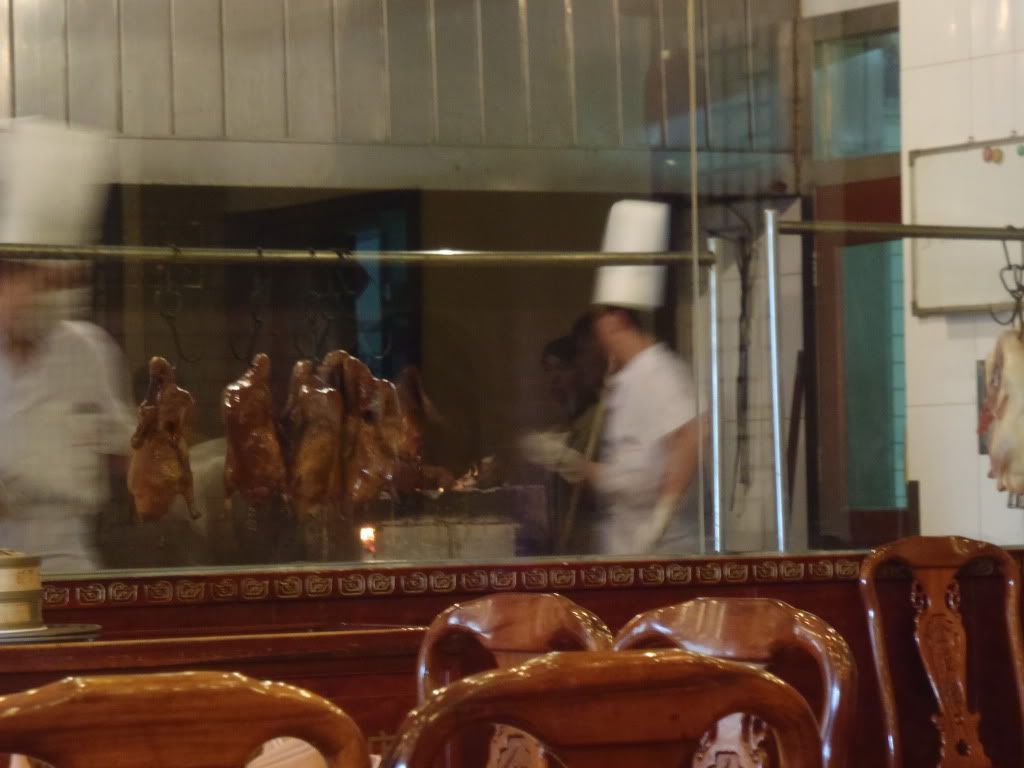
One of the first ones that made it out of the oven was brought to us. A chef skillfully sliced up half a duck and delivered the meat to the table. A waitress explained the process of making little Peking Duck pancakes to us: first you take a little pancake, which you cover in plum sauce and add scallions to, after which you add some duck to finish the whole thing off by rolling the pancake up and eating the whole thing. A second delicacy is the duck skin, which is picked up and first dipped into plum sauce and then sugar. Francesca surprised me as she skillfully prepared herself the little snacks. Before we knew it the plate was empty and we had to order another half-duck to fill us up.
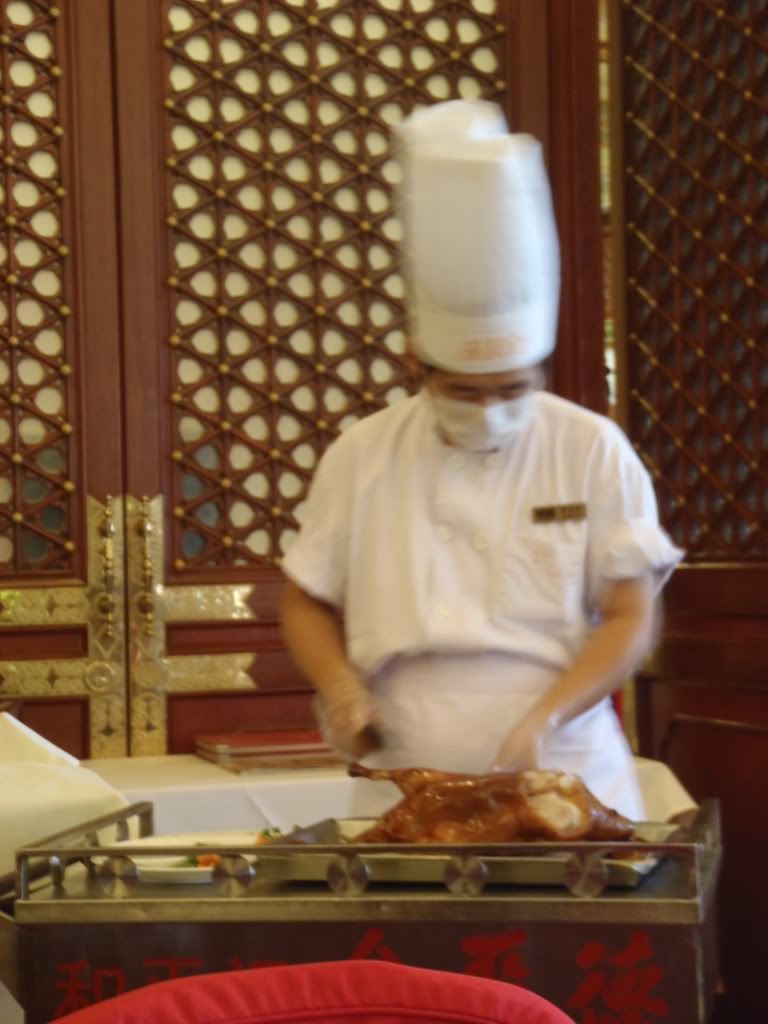

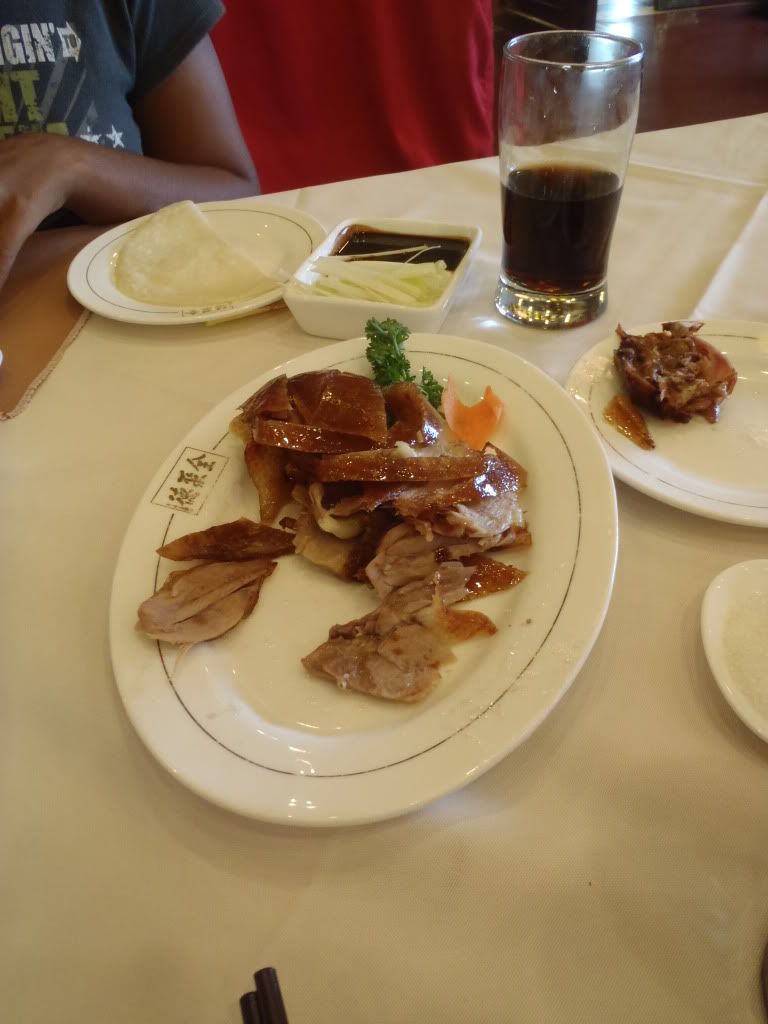
The second duck was as sumptuous as the first one. We didn’t manage to finish all of it and got the left-overs to go. A subway station happened to be nearby, and the 1 hour plus commute could begin once more. We reached Tiantongyuan North well past 7:00 PM, picked up a watermelon for Kevin and jumped in the taxi.
